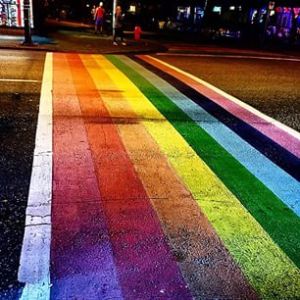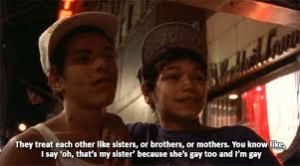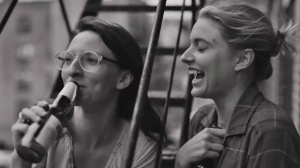Currently, my girlfriend and I cannot get married. Not that we’re planning our Pinterest pages or anything, but the point is: same-sex marriage is illegal in Australia. Recently a friend shared this video, an ad in support of the “Yes” vote for the upcoming Irish referendum on same-sex marriage:
What struck me most was the emphasis on “family” made in the video created by BeLong To youth services, underscored by the tagline “Bring Your Family With You.” I was torn by this message. While the idea of parents and extended family coming out in support of their lesbian, gay and bisexual relatives is moving (albeit unrealistic for many), it also reinforces the idea that this fight is centrally about maintaining the primacy of the blood-related family in society, which only extends itself via legal marriage.
This idea of family is far from the reality in many queer communities, where kinship ties are made with many non-blood relatives, especially for those who are thrown out of home when they come out. This different conception of “family” in the queer community is illustrated most clearly in the 1989 documentary ‘Paris is Burning.’ Created by Jeannie Livingstone, the film reveals an underground world in New York of “drag balls” where young (often homeless) African American and Hispanic youth find belonging, joining different ball “families” who compete and perform. Ask anyone who has found belonging in LGBTIQ spaces, and I’m sure they’ll tell you that family often means much more than who your genetic relatives are or who you are legally bound to.

Some people have used unique ways such as combining handfasting with traditional marriage, to represent polyamorous union
It is also important to note that within queer communities sexual and emotional partnerships are not always so clearly between two people. Campaigns for marriage equality generally seek to change the legal definition of marriage from that between “a man and a woman” to “same-sex” marriage but still for a partnership of two. This does not reflect the reality of many queer people’s lives, who may be in polyamorous relationships or who might enjoy other partnership dynamics not reflected by a dualistic definition. Add to this the fact that many transgender and intersex people are often left out of proposed “same-sex” marriage bills, and you can see that the fight for marriage equality sometimes refers to a very narrow idea of partnership and family that is in conflict with many queer people’s experiences.
 I raise all of these points to highlight the very important fact that “marriage equality” often does not reflect the kind of relations that currently occur in queer communities, nor the central needs of these communities, and to that end is not the “final” frontier of LGBTIQ rights. However, this does not mean that marriage equality is not worth fighting for.
I raise all of these points to highlight the very important fact that “marriage equality” often does not reflect the kind of relations that currently occur in queer communities, nor the central needs of these communities, and to that end is not the “final” frontier of LGBTIQ rights. However, this does not mean that marriage equality is not worth fighting for.
Every time my girlfriend and I go to a wedding we are reminded that we do not enjoy the same legal rights as our heterosexual friends because of our sexuality. Here the ban on same-sex marriage acts as a symbol of difference and exclusion. Some in the queer community argue that difference is good, and should be celebrated: assimilation is not the way. Although it’s all well and good to embrace difference, it’s quite another story when you have the law labelling you as different. Some have also suggested that gay marriage creates a situation where there are “good” (married) gays and “bad” (unmarried) ones. However, we can already see that unmarried versus married straight people are sometimes treated differently in society, which highlights that the problem here is how we value marriage altogether, not whether some people should be allowed to marry. Often I forget that I’m in a “same-sex” relationship until I get reminded by society; discrimination on the basis of having a loving relationship with someone seems utterly ridiculous.
 The fact that you are legally obliged to read out the definition of marriage as “between a man and a woman” at weddings in Australia also causes our sympathetic straight friends much guilt, consternation and dismay. Often celebrants read out the law, and then at the bride and groom’s request make commentary on their rejection of the definition. While some do this quickly and quietly, the best way I have seen this dealt with is to labour on the point. When straight couples get up at weddings and say “this law is outrageous!” I think this makes the point better than “abstaining” from marriage altogether.
The fact that you are legally obliged to read out the definition of marriage as “between a man and a woman” at weddings in Australia also causes our sympathetic straight friends much guilt, consternation and dismay. Often celebrants read out the law, and then at the bride and groom’s request make commentary on their rejection of the definition. While some do this quickly and quietly, the best way I have seen this dealt with is to labour on the point. When straight couples get up at weddings and say “this law is outrageous!” I think this makes the point better than “abstaining” from marriage altogether.
 Many feminists in the West have fought against the insular and restrictive aspects of the institution of marriage since the 1960s. The gains of this have been changes to social understandings of marriage, where women are no longer seen as the property of their husbands, and where divorce is a legitimate option for those in unhappy or dangerous partnerships. While the institution of marriage is not perfect, and indeed is an institution where the law comes into the intimate sphere of a relationship, it is arguably not what it used to be. Except that is still between “a man and a woman” (in Australia at least).
Many feminists in the West have fought against the insular and restrictive aspects of the institution of marriage since the 1960s. The gains of this have been changes to social understandings of marriage, where women are no longer seen as the property of their husbands, and where divorce is a legitimate option for those in unhappy or dangerous partnerships. While the institution of marriage is not perfect, and indeed is an institution where the law comes into the intimate sphere of a relationship, it is arguably not what it used to be. Except that is still between “a man and a woman” (in Australia at least).
 Of the weddings I have been to, what I have seen is a celebration of people in love, making a public declaration in front of their friends and family (however that is defined). Sure, queer people can still have parties that mimic this, but while discriminatory laws are in place there is ever the reminder that inequality between heterosexual and homosexual people is legally sanctioned in this country.
Of the weddings I have been to, what I have seen is a celebration of people in love, making a public declaration in front of their friends and family (however that is defined). Sure, queer people can still have parties that mimic this, but while discriminatory laws are in place there is ever the reminder that inequality between heterosexual and homosexual people is legally sanctioned in this country.
 The fight for marriage equality is not the end of the road for LGBTIQ rights, not by a long shot. But it is an important stone in the path to justice, and winning equal marriage in Australia would remove one roadblock that we keep getting stuck on. So let’s fight to open up this path, not stopping at marriage, and along the way take everyone with us in the fight against entrenched discrimination.
The fight for marriage equality is not the end of the road for LGBTIQ rights, not by a long shot. But it is an important stone in the path to justice, and winning equal marriage in Australia would remove one roadblock that we keep getting stuck on. So let’s fight to open up this path, not stopping at marriage, and along the way take everyone with us in the fight against entrenched discrimination.










 S is for
S is for



